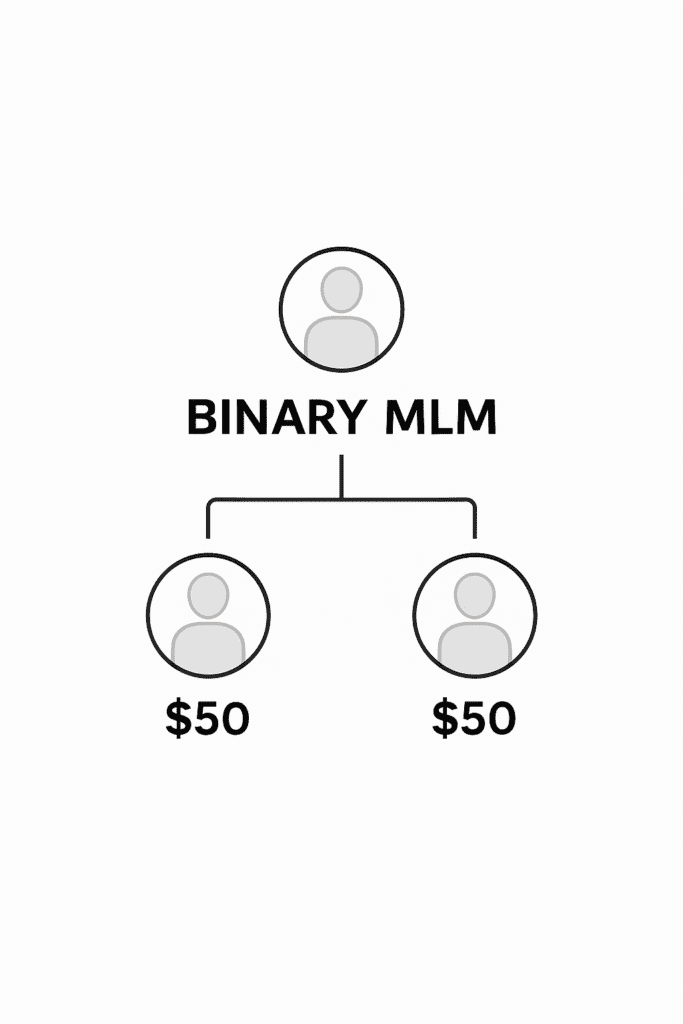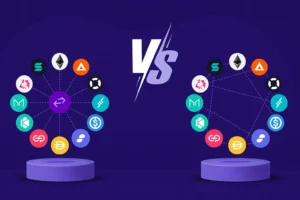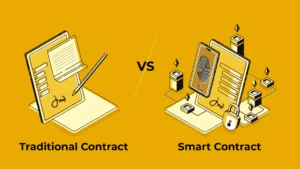
In traditional MLM, users earn income by selling products and recruiting others into the network. However, one of the biggest drawbacks of conventional MLM systems has been lack of transparency, manual commission payouts, and trust issues.
Now, with blockchain technology and smart contracts, these concerns are being solved. A crypto MLM system ensures instant, transparent, and automated commission distribution without any third-party interference.
In 2025, as blockchain adoption accelerates, crypto-based MLM plans are becoming a global trend — empowering entrepreneurs, startups, and communities to build scalable and borderless income ecosystems.
What Is a Cryptocurrency MLM Plan?
A Cryptocurrency MLM Plan is a decentralized multi-level marketing system built on blockchain technology. Participants earn rewards in digital currencies by referring others and expanding their team. The plan logic — including registration, referral, payout, and commission distribution — is encoded into a smart contract, which executes automatically whenever specific conditions are met.
Unlike traditional MLM companies, which rely on centralized databases and manual record-keeping, crypto MLMs store all user data and transactions on a public blockchain ledger. This ensures complete transparency, zero manipulation, and full automation.
- Joining
- Referral tracking
- Level updates
- Commission payout
Also Read: What Is MLM? How It Works in the Real World and Its Global Legality.
Core Features
- Blockchain-based logic: Every rule encoded in a smart contract
- Crypto rewards: Commissions paid in USDT, BNB, ETH, etc.
- No human interference: Payouts happen automatically
- Immutable ledger: All transactions are recorded permanently
- Global access: Anyone can join from anywhere with a wallet
Example:
Suppose “John” joins a crypto MLM platform by paying 100 USDT.
The smart contract automatically distributes:
- 50 USDT to John’s upline
- 30 USDT to second-level referrer
- 20 USDT to platform pool
No admin is needed — it’s fully automated.
How Does a Cryptocurrency MLM Plan Work?
A Crypto MLM Plan works as a decentralized network marketing system powered by blockchain smart contracts. Unlike traditional MLMs that depend on company-led databases, manual accounting, and delayed payouts, a crypto MLM system is completely automated. Every participant’s action — joining, referring others, paying the entry fee, or receiving commissions — is governed by smart contract logic stored on the blockchain.
Here’s how it works: when a new user joins through a referral link shared by an existing member, they connect their crypto wallet (like MetaMask, Trust Wallet, or TronLink) to the platform. They then pay a joining fee or buy a membership package in cryptocurrency (most often in USDT, BNB, ETH, or TRX). The smart contract automatically verifies the transaction, records the new user’s data on-chain, assigns them under their referrer, and distributes commissions instantly to the appropriate upline members based on the chosen MLM structure (e.g., Binary, Matrix, Unilevel).
Step-by-Step Working Process
- User Registration
- A new user joins using a referral link shared by an existing member.
- They connect their crypto wallet to the platform.
- The system identifies their sponsor and places them in the correct hierarchy.
- Package Purchase / Entry Fee Payment
- The user pays the joining fee or buys a staking/membership package using crypto (e.g., USDT or BNB).
- The smart contract validates and records the transaction on-chain.
- Smart Contract Execution
- Instantly after payment, the smart contract logic runs:
- Updates the user’s referral tree
- Allocates the commission to uplines
- Triggers bonuses or rank updates automatically.
- Instantly after payment, the smart contract logic runs:
- Instant Commission Distribution
- Payouts are immediate — funds are sent directly to uplines’ wallets without admin action.
- Every distribution is recorded on the blockchain, visible to everyone.
- Real-Time Dashboard & Tracking
- The user’s dashboard shows total referrals, downline size, income earned, and team progress.
- All data syncs with the smart contract, ensuring accuracy and transparency.
- Autonomous & Borderless Operation
- No company holds the funds — everything is decentralized.
- Anyone with a wallet can join from any country, enabling global scaling.
- The system operates 24/7 without downtime or central authority.
Why Blockchain Is a Game-Changer for MLM?
Blockchain technology is transforming MLM systems by introducing automation, transparency, and immutability. In traditional MLMs, users rely on a central company to track referrals and release commissions — a process prone to errors and fraud. Blockchain removes these vulnerabilities through self-executing smart contracts that eliminate the need for trust.
Because every transaction is recorded publicly, participants can verify their commissions in real-time. The blockchain ledger ensures that no one can alter data, hold funds, or manipulate earnings. Moreover, global crypto wallets make it easy for anyone to join from any country, bypassing traditional payment systems.
Blockchain Advantages
- Transparency: All transactions visible to everyone
- Automation: Smart contracts execute rules automatically
- Security: Immutable ledger prevents tampering
- Borderless Payments: Global access via crypto wallets
- Elimination of Fraud: No dependency on admin or central control
Popular Cryptocurrency MLM Compensation Models
The success of any MLM system depends on its compensation plan, which defines how income flows within the network. In cryptocurrency MLMs, these plans are encoded into smart contracts, ensuring consistent, fair, and instant payouts.
1. Binary MLM Plan
Each member has two sub-members (left and right). Income is based on balancing both legs.
Example: If left = 1000 USDT, right = 800 USDT, commission is on 800 USDT.

Advantages:
- Promotes balanced team growth
- Encourages teamwork
- Simple structure
- Easy to scale
- Automated binary matching
2. Unilevel MLM Plan
Each user can directly refer unlimited members on level 1 and earn commissions from multiple levels.
Advantages:
- Unlimited width
- Earnings from depth
- Simple tracking
- Stable long-term income
- Best for beginners
3. Matrix MLM Plan (e.g., 3×3)
Fixed structure (like 3 members per level). Once full, spillovers go to next level or upline.
Advantages:
- Team collaboration
- Fair spillover system
- Predictable income
- Great for automation
- Encourages teamwork
4. Generation Plan
Rewards based on leadership ranks. Users earn commission from generations below.
Advantages:
- Promotes leadership
- Rank-based rewards
- Encourages mentoring
- High retention
- Ideal for advanced marketers
5. Board Plan
Participants move through boards as they recruit others. Completing a board gives bonus and promotion.
Advantages:
- Motivational milestones
- Clear progress tracking
- High reward potential
- Automated transitions
- Suitable for short cycles
Key Features of a Crypto MLM Platform
A successful cryptocurrency mlm software combines blockchain technology with user-friendly interfaces and secure management. The platform should allow seamless onboarding, instant payouts, and complete visibility of referrals and income.
Core Features
- Smart Contract Integration – automates referral logic and payouts
- Wallet Connectivity – supports MetaMask, Trust Wallet, TronLink
- Real-Time Dashboard – shows income, team size, and levels
- Multi-Currency Support – USDT, BNB, ETH, MATIC, etc.
- Admin Analytics Panel – track performance and revenue
- Mobile Responsive UI – easy access via web and mobile
Benefits of a Cryptocurrency MLM System
The blend of blockchain and MLM unlocks a series of advantages that make it more efficient and trustworthy than traditional systems.
Major Benefits
- Full Transparency: Every payment traceable on-chain
- Instant Payouts: No delay or manual release
- Global Reach: Anyone with a wallet can join
- Automation: No human interference
- Low Cost: No middlemen or bank charges
- Immutable Records: Cannot be manipulated
- Trustless System: Users rely on code, not admin
Challenges & Risks in Crypto MLM
Despite its advantages, a crypto MLM model comes with potential challenges that must be carefully managed.
Common Challenges
- Smart Contract Bugs – can cause payout errors
- Volatile Crypto Values – earnings may fluctuate
- Regulatory Uncertainty – laws differ per country
- Fraudulent Projects – misuse MLM structure
- Complex User Education – users must understand wallets & gas fees
Solutions
- Hire experienced developers
- Use stablecoins (USDT)
- Conduct smart contract audits
- Provide training guides for users
Cryptocurrency Mlm Plans Faq
Is Cryptocurrency MLM Legal?
The legality of a Cryptocurrency MLM depends entirely on how it’s structured and operated. MLM itself is not illegal; what makes a system illegal is when it becomes a Ponzi scheme or promises fixed returns without real utility or product.
In crypto MLMs, legality can be ensured by maintaining full transparency, avoiding guaranteed ROI schemes, and adhering to KYC (Know Your Customer) and AML (Anti-Money Laundering) regulations. Governments and regulators primarily want to ensure consumer protection and financial traceability.
If your system runs on audited smart contracts, offers real services or token utility, and complies with local financial intelligence units (like FIU-India), it can operate legally in most jurisdictions.
Key Legal Guidelines:
-
Operate under FIU-registered entity for compliance (in India)
-
Avoid fixed-return promises (no Ponzi structure)
-
Implement KYC & AML for all users
-
Use audited smart contracts to ensure fairness
-
Maintain transparent documentation (whitepaper, terms)
Which Blockchain Is Best for a Crypto MLM Platform?
Choosing the right blockchain is critical for performance, cost, and adoption.
The most preferred network is Binance Smart Chain (BSC) because of its low transaction fees, high speed, and EVM compatibility. It supports smart contracts in Solidity, making development faster and cheaper.
However, depending on your goals, Ethereum, Polygon, or Tron are also strong contenders. Ethereum offers security and trust, Polygon offers scalability, and Tron is known for low gas and quick settlements.
Recommended Chains:
-
Binance Smart Chain (BSC): Low fees, fast, developer-friendly
-
Ethereum (ETH): Highly secure and trusted ecosystem
-
Polygon (MATIC): Scalable and EVM compatible
-
Tron (TRX): Extremely fast with minimal cost
-
Multi-chain integration possible for cross-platform flexibility
-
Select based on cost, speed, and target audience
Can Smart Contracts Fail or Get Hacked?
Yes, if not coded or audited properly, smart contracts can contain bugs or vulnerabilities. A single coding mistake can lead to fund loss or exploits. Therefore, rigorous code testing, third-party security audits, and best practices are essential.
Modern development uses tools like Slither, MythX, and Hardhat testing to catch logical errors. Always choose experienced blockchain developers who follow security-first architecture.
How to Prevent Failures:
-
Use experienced Solidity developers
-
Conduct manual and automated audits (e.g., CertiK, AuditOne)
-
Implement security patterns (e.g., reentrancy guard)
-
Test on testnets before deployment
-
Use multi-signature wallets for admin control
-
Avoid upgradable contracts unless audited
How Do Users Earn in a Crypto MLM?
Earnings come from a performance-based structure, not fixed returns.
Users earn commissions, bonuses, and rewards through referrals, team building, and rank achievements. As their network grows, they unlock new levels and receive higher percentage payouts.
This ensures fairness — only active contributors earn, while passive users depend on their network performance.
Income Sources:
-
Direct Referral Income – from immediate recruits
-
Level Income – from downline activity
-
Rank Bonus – based on leadership achievements
-
Team Bonus – cumulative network performance
-
Matching Bonus – proportionate to group sales
-
Special Rewards – milestone achievements (cars, gadgets, tokens)
Can the System Be Customized?
Yes, a crypto MLM platform is fully customizable.
You can define the plan structure (binary, matrix, unilevel), number of levels, commission percentages, and even custom tokens for payout.
Branding, UI/UX, dashboard analytics, and reward rules can be tailored according to your business model and target audience.
Customization Options:
-
Choose MLM Plan Type (Binary / Matrix / Unilevel / Hybrid)
-
Define Levels, Ranks, and Bonus Structures
-
Integrate Custom Tokens or Stablecoins
-
Add Staking, Rewards, or NFT badges
-
Design Branded dashboards and mobile apps
-
Configure language and currency localization
What About Crypto Volatility and Risk?
Cryptocurrency prices can fluctuate significantly, which may affect user trust and payouts.
To avoid this, most MLM systems use stablecoins like USDT or USDC for all transactions. These coins are pegged 1:1 with the USD, ensuring that income value remains stable regardless of market changes.
This protects both the company and users from unexpected losses due to volatility.
Risk Management Practices:
-
Use stablecoins (USDT/USDC) for payments
-
Avoid volatile coins for payout (e.g., BTC/ETH)
-
Maintain reserve pools for liquidity stability
-
Provide real-time wallet tracking
-
Offer staking or lock-in options for added rewards
-
Regularly monitor market conditions
How Long Does Development Take?
A professional crypto MLM project typically takes 3 to 5 weeks, depending on complexity and features.
If you need multi-chain integration, mobile app support, or advanced analytics, it may take 6–8 weeks. The process includes planning, coding, testing, auditing, and deployment.
Efficient teams can deliver a fully audited and tested platform within one month.
Development Timeline:
-
Requirement Analysis: 3–5 days
-
Smart Contract Development: 7–10 days
-
Frontend & Backend UI: 10–12 days
-
Testing & QA: 5–7 days
-
Audit & Final Deployment: 3–5 days
-
Total Duration: ~3–5 weeks
Can It Support Multiple Cryptocurrencies?
Yes, modern MLM platforms can be built as multi-chain systems, supporting several cryptocurrencies.
Users can join and pay in BNB, ETH, TRX, or USDT, while the smart contract converts values or executes payouts in a preferred coin.
This flexibility attracts a broader user base and allows smoother global onboarding.
Multi-Currency Capabilities:
-
Accept payments in BNB, ETH, MATIC, TRX, USDT
-
Auto-convert or distribute in stablecoins
-
Add cross-chain bridging for advanced users
-
Integrate multi-wallet compatibility
-
Configure token whitelist for allowed assets
-
Set preferred payout token globally
Where Can I Get It Built Professionally?
o build a secure, reliable, and scalable system, you need a specialized blockchain development firm.
Companies like Nadcab Labs are experienced in developing crypto MLM systems, smart contracts, and decentralized applications (dApps). They offer end-to-end solutions — from concept to deployment and audit. Choosing an expert ensures your platform runs safely, legally, and efficiently.
What to Look for in a Development Partner:
-
Proven experience in Blockchain + MLM systems
-
Team skilled in Solidity, Web3.js, React, Node.js
-
Includes UI design, backend, and smart contract audit
-
Delivers source code ownership and deployment support
-
Provides ongoing maintenance & upgrades






